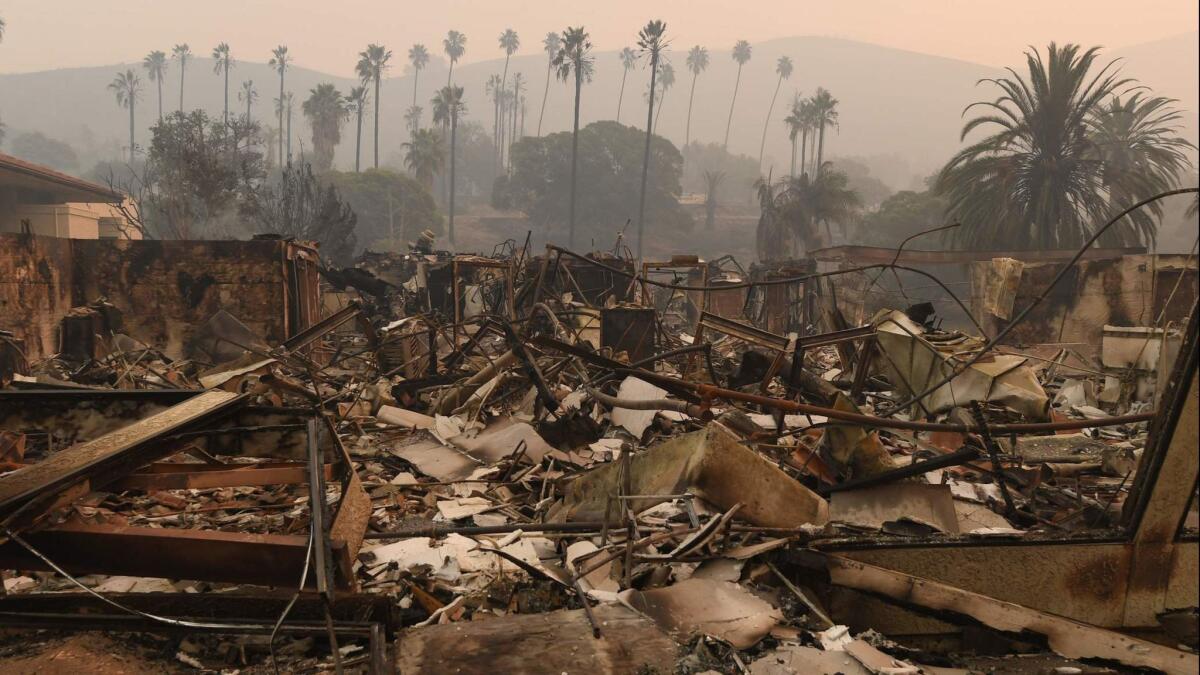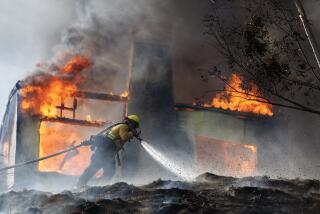Column: Big utilities are desperately trying to stick customers for the bills from California wildfires

Does there exist anywhere a whinier, more petulant, more entitled gang of businesses than California’s big utility companies?
PGE Corp., Edison International, and Sempra — the parents of Pacific Gas & Electric, Southern California Edison and San Diego Gas & Electric— connived in the state’s misbegotten electricity deregulation program of 2000-2001, then complained bitterly about how much it cost them. PG&E tried to foist a stealth ballot measure on voters to hamstring competing public power agencies. The companies have mismanaged their nuclear power plants to the point that one of the two plants has been prematurely shut down and the other will soon be in mothballs.
And now the utilities, which earned a combined $3 billion in profits last year on nearly $41 billion in revenues, are moving on several fronts to limit their liability for wildfires sparked by their own lines or equipment. Their goal is to stick taxpayers or their customers — rather than their own shareholders — for the costs of damages resulting from those fires.
There is absolutely no evidence these companies would go bankrupt. They’re basically looking for a get-out-of-jail-free card.
— Jamie Court, president, Consumer Watchdog
They’re concerned because under the strict liability doctrine prevailing in California in cases of fire damage related to utility facilities, owners of damaged homes or property don’t have to show that the fires were the result of negligence to collect from the utilities.
The causes of the most recent wildfires in California, which took 44 lives in the wine country and destroyed thousands of homes in Northern and Southern California, haven’t yet been fully established. But utility equipment, including downed and live power lines, is often implicated in such events.
According to state officials, power lines and electrical equipment are a leading cause of wildfires — linked to the scorching of 149,241 acres in 2015, the latest year for which figures are available. That’s more than twice the acreage burned by any other cause. Utilities are responsible for cutting back vegetation that could come into contact with electrical equipment and loose tree limbs that could bring down lines.
The utilities argue that climate change is making wildfires worse, in part by turning California’s woodlands hotter and drier. At a meeting in mid-January with state policymakers, the three major utilities argued that this is imposing “a disproportionate share of the risk” on their customers and shareholders, according to talking points they prepared for the meeting.
They warned that their very existence is under threat from what PG&E told me through a spokesman is their “essentially unlimited liability” for wildfire-related damages.
That exposure, the company says, “undermines the financial health of the state’s utilities, discourages investment in California and has the potential to materially impact the ability of utilities to access the capital markets.… All of these are bad for customers and bad for the state of California.”
Heightening the utilities’ fears, last November a California Public Utilities Commission administrative law judge rejected San Diego Gas & Electric’s bid to pass $379 million in expenses from three 2007 wildfires in San Diego County on to its ratepayers.
The judge ruled that the utility failed to “reasonably manage and operate its facilities” prior to the blazes. If the ruling stands, SDG&E’s shareholders will be on the hook. That’s a signal that the PUC may expect the utilities to do much more to reduce the chances that lines and equipment can spark fires in dry, forested areas.
Consumer advocates naturally are skeptical of the utilities’ poor-mouthing. “There is absolutely no evidence these companies would go bankrupt,” says Jamie Court, president of Consumer Watchdog. “They’re basically looking for a get-out-of-jail-free card.”
Yet there is wide agreement that California may need to reconsider how to apportion the costs of wildfire damage. “The fire costs are going to be increasing, and there’s probably a limit to what the utilities have the capacity to do,” says Sean Hecht, an environmental law expert at UCLA. “This is emblematic of a whole host of problems we’re going to see from climate change, where in the aggregate everybody loses and the question is how you allocate those costs.”
But the process involves a delicate balancing act. Even if the utilities deserve some relief from their liability for fire damage, Hecht says, the prospect they’ll have to compensate victims for property damage gives them an incentive to harden their systems against the chance that they may spark a fire. And the suggestions for providing relief tend to amount to imposing costs on someone else, such as taxpayers.
The utilities are fighting on two fronts to limit their liability. One is the state legislature.
“They’ve been working hard in this building trying to change the narrative around wildfires,” state Sen. Jerry Hill (D-San Mateo) told me from his capitol office in Sacramento. “They say it’s climate change, it’s the ‘new normal,’ and we shouldn’t hold them responsible anymore. They’re doing everything they can to change the law to protect themselves.”
The industry is supporting a bill introduced by Sen. Bill Dodd (D-Napa) creating a new procedure for setting standards for utility activities in fire zones. Dodd’s measure would require the utilities to submit plans to the PUC encompassing safety rules, standards and practices. As long as a utility adhered to its plan, the PUC would be required to allow it to recover damage expenses from ratepayers, even if its equipment contributed to a fire.
Critics say the bill undermines the prevailing standard setting forth when customers, rather than shareholders, bear the costs of utility operations. Currently, customers pay for utility expenses through their rates as long as the PUC finds that a utility has incurred those “prudently.” Dodd’s bill would automatically deem a utility’s actions “prudent” as long as it remained in compliance with its fire safety plan.
But no plan can foresee all the ways that a utility might screw up, says Tom Long, legal director of the consumer advocacy group the Utility Reform Network (TURN). Dodd’s bill, he says, places sharp limits on the PUC’s discretion with the goal of “shifting the risk from shareholders to ratepayers.”
Dodd says his bill aims to force utilities to file comprehensive safety plans proactively and stick to them, or face “very significant penalties,” although those aren’t specified in the bill. He has amended the measure to give the PUC more authority over the plans, but Long says the bill still is excessively favorable to the utilities.
The utilities’ second front is in state court, where they’re mounting an attack on a legal principle known as inverse condemnation. The principle says that when a governmental or quasi-governmental entity takes property for a public benefit, the cost should be spread among all members of the community.
In the event of wildfires, it means that the owners of damaged property should be compensated without having to show their losses were caused by utilities’ negligence, only that the losses were linked to utility activities.
In two lawsuits over past California fires, PG&E and Southern California Edison have argued that inverse condemnation should be abandoned. They say the doctrine presupposes that they can spread the costs from fire damage throughout the community by absorbing them into rates. But the November ruling against SDG&E, they say, shows that there’s no guarantee they can do so.
Legal experts say that’s an unpromising argument, since inverse condemnation is an implicit provision of both the California and U.S. constitutions. Indeed, on Tuesday a judge in Sacramento County Superior Court rejected PG&E’s motion to overturn its liability under inverse condemnation in a case involving the 2015 Butte fire, which destroyed 475 homes in Amador and Calaveras counties.
“PG&E has all the benefits of a governmental entity,” says Steven Campora, a lawyer representing victims of the Butte fire. “They have a monopoly and a guaranteed profit, the right of eminent domain and access to your private property to put their lines in, yet they don’t want the burden of inverse condemnation. For some reason they think they shouldn’t have personal responsibility like the rest of us.”
A hearing on Edison’s similar motion in Los Angeles County Superior Court in a case involving the Round fire, which injured four persons and destroyed 40 homes in Inyo and Mono counties, is set for June 15. Also pending are lawsuits linking Edison to the Thomas fire, which destroyed more than 1,000 buildings in Ventura and Santa Barbara counties.
Experts warn against relieving utilities of their liability for fire damage, lest they lose the incentive to maintain safety standards. “It’s still the case that the utilities are the best placed to prevent failure at their facilities,” says Alejandro Camacho, a professor at UC Irvine law school. “It’s foreseeable that these failures will cause real harms to people, so over the next several decades, they should work their darndest to make sure these harms don’t occur.”
Keep up to date with Michael Hiltzik. Follow @hiltzikm on Twitter, see his Facebook page, or email [email protected].
Return to Michael Hiltzik’s blog.
UPDATES:
7:26 a.m., May 5: This post has been corrected to reflect that the lawsuit scheduled for a June 15 hearing involves the Round fire, not the Thomas fire.
More to Read
Inside the business of entertainment
The Wide Shot brings you news, analysis and insights on everything from streaming wars to production — and what it all means for the future.
You may occasionally receive promotional content from the Los Angeles Times.











